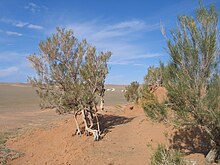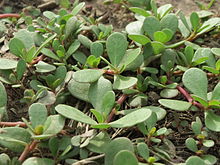List of C4 plants
In botany,
C4 photosynthesis probably first evolved 30–35 million years ago in the
C4 plants are usually identified by their higher 13C/12C
The following list presents known C4 lineages by family, based on the overview by Sage (2016).[1] They correspond to single species or clades thought to have acquired the C4 pathway independently. In some lineages that also include C3 and C3–C4 intermediate species, the C4 pathway may have evolved more than once.[1]








Acanthaceae
The large acanthus family Acanthaceae includes one genus with C4 species, found in dry habitats from Africa to Asia.[8]
- Blepharis – 15 C4 species, 1–4 origins
Aizoaceae
While many species in the ice plant family
- Sesuvioideae– 30 C4 species, 1–6 origins
Amaranthaceae
The amaranth family Amaranthaceae (including the former goosefoot family Chenopodiaceae) contains around 800 known C4 species, which belong to 14 distinct lineages in seven subfamilies. This makes Amaranthaceae the family with most C4 species and lineages among the eudicots.[1] Suaeda aralocaspica and species of the genus Bienertia use a particular, single-cell type of C4 carbon fixation.[1][10]
- Aerva (Amaranthoideae) – 4 C4 species[11]
- Alternanthera (Gomphrenoideae) – 17 C4 species (also includes C3–C4 intermediates)[11]
- Amaranthus (Amaranthoideae) – 90 C4 species[11]
- Atriplex (Chenopodioideae) – around 180 C4 species[12]
- Camphorosmoideae) – 24 C4 species (also includes one C3–C4 intermediate), 1–2 origins[13]
- Bienertia (Suaedoideae) – 3 C4 species[10][14]
- Gomphrenoids (Gomphrenoideae) – 138 C4 species[11]
- Suaeda aralocaspica (Suaedoideae)[10]
- Suaeda sect. Salsina – 30 C4 species[10]
- Suaeda sect. Schoberia – 9 C4 species[10]
- Tecticornia – (Salicornioideae) 2 C4 species[17]
- Tidestromia (Gomphrenoideae) – 8 C4 species[11]
Asteraceae
The composite family Asteraceae contains three C4 lineages, in two different tribes of subfamily Asteroideae.[1][18] They include the model genus Flaveria with closely related C3, C4, and intermediate species.[1]
- Flaveria (Tageteae) – 7 C4 species, 2–3 origins (also includes C3 and intermediate)[1][19][20]
- Coreopsideae – 41 C4 species[18]
- Pectis (Tageteae) – 90 C4 species[21]
Boraginaceae
The borage family Boraginaceae contains one widespread C4 genus, Euploca, which has also been treated as part of a distinct family Heliotropiaceae.[22]
Cleomaceae
The Cleomaceae, formerly included in the caper family Capparaceae, contains three C4 species in genus Cleome. These three species independently acquired the C4 pathway; the genus also contains numerous C3 as well as C3–C4 intermediate species.[1][24][25]
Caryophyllaceae
In the carnation family Caryophyllaceae, the C4 pathway evolved once, in a clade within the polyphyletic genus Polycarpaea.[1][26]
- Polycarpaea – 20 C4 species
Cyperaceae
The sedge family Cyperaceae is second only to the grasses in number of C4 species. Prominent C4 sedges include culturally important species such as papyrus (Cyperus papyrus) and chufa (C. esculentus) but also purple nutsedge (C. rotundus), one of the world's major weeds. Eleocharis vivipara uses C3 carbon fixation in underwater leaves and C4 carbon fixation in aerial leaves.[1]
- Bulbostylis – 211 C4 species
- Cyperus – 757 C4 species
- Eleocharis ser. Tenuissimae – 10 C4 species
- Eleocharis vivipara
- Fimbristylis – 303 C4 species
- Rhynchospora – 40 C4 species
Euphorbiaceae
The spurge family Euphorbiaceae contains the largest single C4 lineage among eudicots. The C4 spurges are diverse and widespread; they range from weedy herbs to the only known C4 trees – four species from Hawaii, including Euphorbia olowaluana (up to 10 m) and E. herbstii (up to 8 m).[1][6]
- Euphorbia subgenus Chamaesyce section Anisophyllum (also treated as genus Chamaesyce) – 350 C4 species (also including C3 and C3–C4 intermediate species)
Gisekiaceae
Contains a C4 genus with a single species.
Hydrocharitaceae
Includes the only known aquatic C4 plants.[1]
- Egeria densa
- Hydrilla verticillata
Molluginaceae
The two C4 species within the same genus have acquired the pathway independently.
- Mollugo – 2 C4 species, 2 origins
Nyctaginaceae
Polygonaceae
- Calligonum – 80 C4 species
Portulacaceae
The single genus of this family forms one C4 lineage.
- Portulaca – 100 C4 species, 1–2 origins
Poaceae
The grass family includes most of the known C4 species – around 5000. They are only found in subfamilies of the
- Aristida – 288 C4 species
- Stipagrostis – 56 C4 species
- Chloridoideae (without Centropodieae) – 1596 C4 species
- Centropodia – 4 C4 species
- Eriachne – 50 C4 species
- Tristachyideae – 87 C4 species
- Andropogoneae – 1228 C4 species (incl. maize, sugarcane, sorghum)
- Reynaudia filiformis
- Axonopus – 90 C4 species
- Paspalum – 379 C4 species
- Anthaenantia – 4 C4 species
- Arthropoginae/Mesosetum clade – 35 C4 species, 1–2 origins
- Arthropoginae/Onchorachis clade – 2 C4 species
- Arthropoginae/Colaeteania clade – 7 C4 species, 1–2 origins
- Anthephorinae – 286 C4 species
- Echinochloa – 35 C4 species
- Neurachne–Paraneurachne – 2 C4 species, 2 origins
- Melinidinae–Panicinae–Cenchrinae – 889 C4 species
- Alloteropsis – 5 C4 species, 1–2 origins (incl. C3 and intermediate)
Scrophulariaceae
- Anticharis – 4 C4 species
Zygophyllaceae
- Tribuloideae – 37 C4 species, 1–2 origins
- Tetraena simplex
References
- ^ PMID 27053721.

- PMID 22404472.
- PMID 25263843.

- doi:10.1111/boj.12385.

- ^ PMID 23885869.

- ^ PMID 21875975.

- PMID 16662291.

- ISSN 1058-5893.

- ISSN 1433-8319.
- ^ S2CID 20250636.
- ^ PMID 21636394.

- PMID 21616801.

- .
- ISSN 0363-6445.
- ^ S2CID 25370346.
- ^ ISSN 1058-5893.
- PMID 18390850.
- ^ ISBN 978-0126144406. Retrieved 2018-05-26.
- PMID 21646108.

- PMID 26084484.

- ^ Hansen, D.R. (2012). The molecular phylogeny of Pectis L. (Tageteae, Asteraceae), with implications for taxonomy, biogeography, and the evolution of C4 photosynthesis (Doctoral dissertation). University of Texas, Austin. Retrieved 2018-05-27.

- ISSN 0040-0262. Retrieved 16 June 2018.
- PMID 17727423.

- PMID 17692080.

- S2CID 84983697. Retrieved 16 June 2016.
- PMID 24638165.

